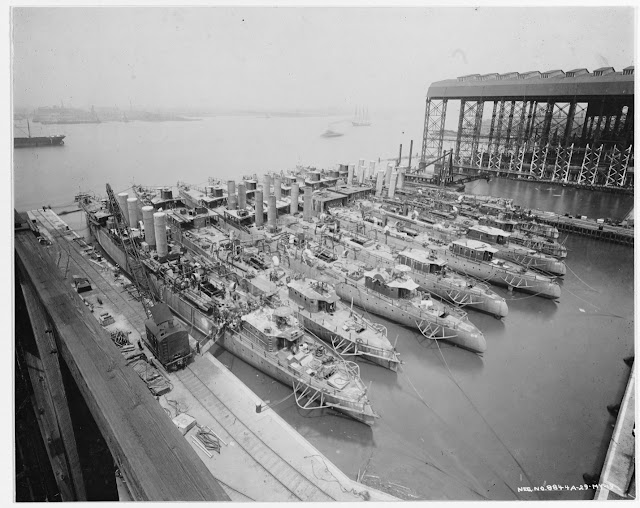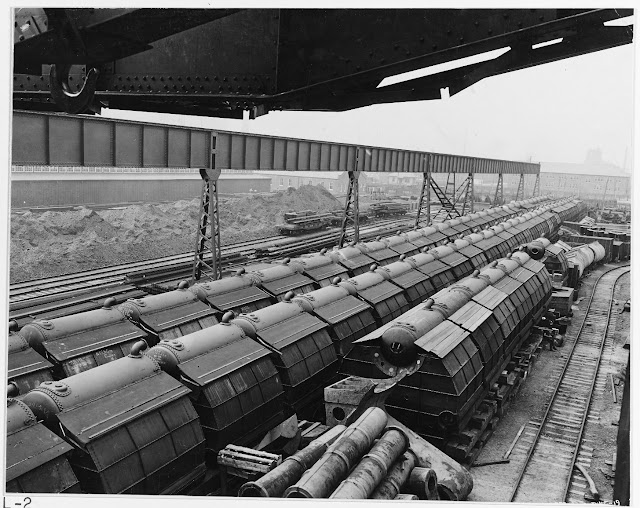I had first assumed that New York Shipbuilding was another name for the Brooklyn Navy Yard. Fortunately, I noticed "CAMDEN. N. J." on the photo.
 |
| [Whoops, I forgot to record the post link.] |
 |
| DestroyerHistory "New York Shipbuilding, once world’s largest shipbuilder, was located not in New York but at Camden, New Jersey, just north of the east end of today’s Walt Whitman Bridge. It was founded in 1898 by Henry Morse, who left the presidency of the Wilmington, Delaware shipbuilder Harlan & Hollingsworth to establish a new yard at Staten Island, New York, but then chose a site across the Delaware River from Philadelphia because of the availability of land, transportation and qualified manpower." Today the site is a port that "handles more than 2 million tons of cargo per year, one of the United States’ largest ports. Portions of its waterfront can still handle deep draft ships including battleship New Jersey which, in 2001, received a $7.2 million renovation before opening as a museum ship." |
 |
| Mesothelioma "New York Shipbuilding Corporation was located in Camden, New Jersey. It operated from 1900 to 1967. The shipyard was active during World War I (WWI), WWII and the Cold War. During WWI, there were so many people working at the shipyard that a self-contained community was established in Camden to house many of the workers. WWII was even more active, with 30,000 employees working for the shipyard and more than 200 ships constructed. After WWII, New York Shipbuilding Corporation began producing nuclear submarines. The shipyard also began converting cruisers to carry guided missiles. In total, the shipyard produced more than 670 ships. However, due to decreasing contracts, New York Shipbuilding Corporation closed in 1967. Upon its closing, the shipyard was reorganized into the South Jersey Port Corporation. It was reopened as the Broadway Terminal in 1971, which remains today....Types of Ships Built/Serviced: Oil tankers, cruisers, battleships, destroyers, coastal liners, aircraft carriers, seaplane tenders, destroyer tenders, nuclear submarines, nuclear merchant ships, replenishment oilers" |
 |
| 43190 Shown circa 1919. The sheds cover the original north yard (begun just before WWI) is to the right. The large merchant hull in the lower left is WENATCHEE, an EFC design 1029 transport which became PRESIDENT JEFFERSON in 1922 and USS HENRY T. ALLEN (APA-15) in 1941. The firefighter near her is either CHAMPION, DEFENDER or SCOTTSBURG. Note the numerous incomplete four stack destroyers. |
 |
| 43191 Aerial photograph, taken circa July 1919. The sheds on the left cover the original North Yard. The light colored gantries in the center are at the pre-World War I Middle Yard. The open ways and the three-bay shed to their right are the Destroyer Yard built for the Navy in 1917. The four open ways further to the right were added during World War I for constructing transports. The large transport fitting out beside the transport ways (in the photograph's right center) is either Southern Cross (later USS Wharton, AP-7), or American Legion (later U.S. Navy AP-35 and APA-117). The transport fitting out to the left is Wenatchee (later USS Henry T. Allen, AP-30 and APA-15). Many incomplete destroyers are also present. U.S. Naval History and Heritage Command Photograph. |
 |
| 43192 Aerial photograph, taken 24 July 1919. Facilities seen, from left to right) are the original North Yard, the pre-World War I Middle Yard, the wartime Destroyer Yard and the wartime Emergency Fleet Corporation Transport Yard. The large transport fitting out in Newton Creek, at right, is either Southern Cross (later USS Wharton, AP-7), or American Legion (later U.S. Navy AP-35 and APA-117). More Design 1029 and 1095 transports are on the shipways in the middle of the view. Many incomplete destroyers are also present. Photographed by the New York Shipbuilding Corporation. U.S. Naval History and Heritage Command Photograph. |
 |
| 43193 The destroyer yard on 1 March 1919. From left to right are probably USS OVERTON (DD-239); STURTEVANT (DD-240); HATFIELD (DD-231) and BROOKS (DD-232). The six hulls in the covered part of the yard to the right are probably DD-233 through 238. HATFIELD was launched on 17 March. |
 |
| 43194 The destroyer yard on 1 April 1919. From left to right are probably USS OVERTON (DD-239); STURTEVANT (DD-240); one ship laid down in March 1919, and BROOKS (DD-232). The ships laid down in March 1919 at N.Y.S.B. were CHILDS (DD-241); SANDS (DD-243); and WILLIAMSON (DD-244). The six hulls in the covered part of the yard to the right are probably DD-233 thru 238. |
 |
| 43195 Destroyers fitting out on 8 April 1919. They are (from left to right): Leary (Destroyer # 158; Builder's # 217); Babbitt (Destroyer # 128; Builder's # 213); Dickerson (Destroyer # 157; Builder's # 216); and Jacob Jones (Destroyer # 130; Builder's # 215). Builder's hull numbers are painted in small numerals on the ships' bows. U.S. Naval History and Heritage Command |
 |
| 43196 Destroyers fitting out on 29 May 1919. These ships are (from left to right): Dickerson (Destroyer # 157, builder's hull # 216); Leary (Destroyer # 158, builder's hull # 217); Schenck (Destroyer # 159, builder's hull # 218); Herbert (Destroyer # 160, builder's hull # 219); Brooks (Destroyer # 232, builder's hull # 221); Hatfield (Destroyer # 231, builder's hull # 220); Babbitt (Destroyer # 128, builder's hull # 213) and DeLong (Destroyer # 129, builder's hull # 214). U.S. Naval History and Heritage Command Photograph. |
 |
| 43197 Babcock & Wilcox boilers at N.Y.S.B. awaiting installation in four-piper destroyers being built at that yard. Markings indicate that some are destined for USTBD 241, 242 and 243 (USS CHILDS; KING and SANDS). Photographed 2 June 1919. |
The following six "4-digit photos" all had this description: "Aerial views of the New York Shipbuilding Corporation on the Camden, New Jersey waterfront along the Delaware River. The shipbuilding facilities can be seen from several angles in both close-up and distant views. Adjacent railroad tracks and neighborhoods are also visible and other parts of Camden can be seen in the distance. The company launched its first ship in 1901 and its last in 1967."
 |
| 1683 |
 |
| 1685 |
 |
| 2516 |
 |
| 7204 |
 |
| 7206 |
 |
| 7207 |
 |
| 15th of 48 photos, cropped New York Shipbuilding Corporation; photographic impressions of the world's largest shipyard. |
 |
| BillyPenn_homes (Satellite, the community was originally called Yorkship Village) "One of the most confusingly named companies in the history of South Jersey was also one of the most important. Called the New York Shipbuilding Corporation, it was massive enough to create a whole neighborhood. How did a company in the Philadelphia region end up with that name? New York Ship, as it was often called, was born in 1899. Founder Henry Morse intended to locate the company at a site in Staten Island. But when he couldn’t secure that plot, he relocated to a spot along the Delaware River in Camden, New Jersey. Morse had already filed the incorporation papers for “New York Shipbuilding Corporation.” And whether out of thrift or laziness, he just decided to keep the name." During WWI, east of the yard, the first federally funded planned community of 1000 homes was built for the workers. |
 |
| BillyPenn_homes |
 |
| BillyPenn_yard "1900: The new yard under construction, a picture taken on August 17, 1900. The covered ways are just beginning to take shape." |
There were five basic objectives followed in the designing and laying out of the new shipyard. Mr. Morse’s advanced ideas were the basis of the planned shipbuilding procedure which he contributed to the industry throughout the world. They were largely the result of his extensive structural steel fabrication experience prior to entering the shipbuilding field.
- First, the application of the mold loft template system for the fabrication of hull steel – a pioneer undertaking for shipbuilding at that time but now standard practice in the industry.
- Second, provisions for prefabrication of relatively large structural assemblies and continuous routing of material from receipt through fabrication shops and on out to the shipways, a method widely publicized as a new development during World War II.
- Third, an unusually complete overhead crane system for handling prefabricated structural assemblies up to 100 tons weight.
- Fourth, a coordinated series of shops with five building ways, and an outfitting basin completely roofed over and served with overhead bridge cranes.
- Fifth, installation of propelling machinery and other heavy weights before launching, by providing 100-ton crane capacity over all the building ways.
Given that the shipyard was built in 1900 and Yorkship Village was built during WWI, I can't believe how wrong this map is.
 |
| 1920 Philadelphia Quad @ 62,500 |
No comments:
Post a Comment